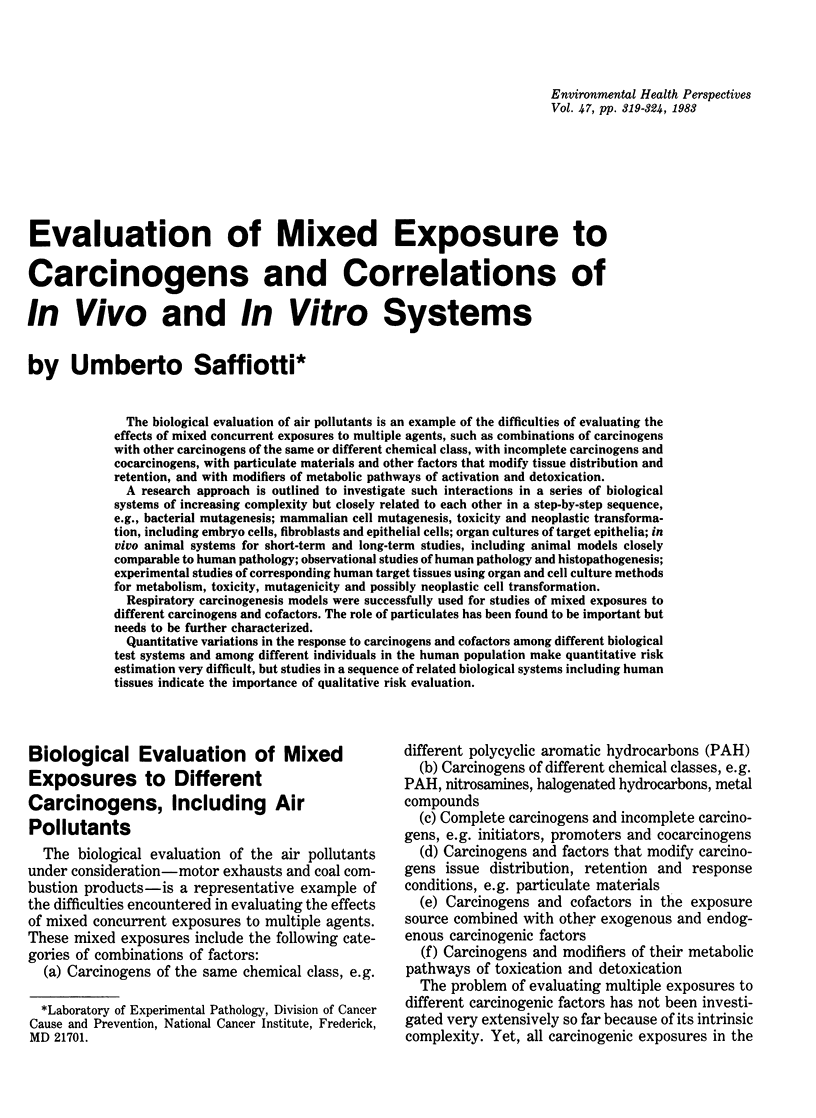Abstract
The biological evaluation of air pollutants is an example of the difficulties of evaluating the effects of mixed concurrent exposures to multiple agents, such as combinations of carcinogens with other carcinogens of the same or different chemical class, with incomplete carcinogens and cocarcinogens, with particulate materials and other factors that modify tissue distribution and retention, and with modifiers of metabolic pathways of activation and detoxication. A research approach is outlined to investigate such interactions in a series of biological systems of increasing complexity but closely related to each other in a step-by-step sequence, e.g., bacterial mutagenesis; mammalian cell mutagenesis, toxicity and neoplastic transformation, including embryo cells, fibroblasts and epithelial cells; organ cultures of target epithelia; in vivo animal systems for short-term and long-term studies, including animal models closely comparable to human pathology; observational studies of human pathology and histopathogenesis; experimental studies of corresponding human target tissues using organ and cell culture methods for metabolism, toxicity, mutagenicity and possibly neoplastic cell transformation. Respiratory carcinogenesis models were successfully used for studies of mixed exposures to different carcinogens and cofactors. The role of particulates has been found to be important but needs to be further characterized. Quantitative variations in the response to carcinogens and cofactors among different biological test systems and among different individuals in the human population make quantitative risk estimation very difficult, but studies in a sequence of related biological systems including human tissues indicate the importance of qualitative risk evaluation.
Full text
PDF





Selected References
These references are in PubMed. This may not be the complete list of references from this article.
- Becci P. J., McDowell E. M., Trump B. F. The respiratory epithelium. II. Hamster trachea, bronchus, and bronchioles. J Natl Cancer Inst. 1978 Aug;61(2):551–561. [PubMed] [Google Scholar]
- Becci P. J., McDowell E. M., Trump B. F. The respiratory epithelium. IV. Histogenesis of epidermoid metaplasia and carcinoma in situ in the hamster. J Natl Cancer Inst. 1978 Aug;61(2):577–586. [PubMed] [Google Scholar]
- Becci P. J., McDowell E. M., Trump B. F. The respiratory epithelium. VI. Histogenesis of lung tumors induced by benzo[a]pyrene-ferric oxide in the hamster. J Natl Cancer Inst. 1978 Aug;61(2):607–618. [PubMed] [Google Scholar]
- Feron V. J., van den Heuvel P. D., Koëter H. B., Beems R. B. Significance of particle size of benzo(a)pyrene for the induction of respiratory tract tumours in hamsters. Int J Cancer. 1980 Feb 15;25(2):301–307. doi: 10.1002/ijc.2910250220. [DOI] [PubMed] [Google Scholar]
- Henry M. C., Kaufman D. G. Clearance of benzo(alpha)pyrene from hamster lungs after administration on coated particles. J Natl Cancer Inst. 1973 Dec;51(6):1961–1964. doi: 10.1093/jnci/51.6.1961. [DOI] [PubMed] [Google Scholar]
- Henry M. C., Port C. D., Bates R. R., Kaufman D. G. Respiratory tract tumors in hamsters induced by benzo(a)pyrene. Cancer Res. 1973 Jul;33(7):1585–1592. [PubMed] [Google Scholar]
- Henry M. C., Port C. D., Kaufman D. G. Importance of physical properties of benzo(a)pyrene-ferric oxide mixtures in lung tumor induction. Cancer Res. 1975 Jan;35(1):207–217. [PubMed] [Google Scholar]
- McDowell E. M., Barrett L. A., Glavin F., Harris C. C., Trump B. F. The respiratory epithelium. I. Human bronchus. J Natl Cancer Inst. 1978 Aug;61(2):539–549. [PubMed] [Google Scholar]
- McDowell E. M., McLaughlin J. S., Merenyl D. K., Kieffer R. F., Harris C. C., Trump B. F. The respiratory epithelium. V. Histogenesis of lung carcinomas in the human. J Natl Cancer Inst. 1978 Aug;61(2):587–606. [PubMed] [Google Scholar]
- Montesano R., Saffiotti U., Ferrero A., Kaufman D. G. Synergistic effects of benzo(alpha)pyrene and diethylnitrosamine on respiratory carcinogenesis in hamsters. J Natl Cancer Inst. 1974 Nov;53(5):1395–1397. doi: 10.1093/jnci/53.5.1395. [DOI] [PubMed] [Google Scholar]
- Saffiotti U., Cefis F., Kolb L. H. A method for the experimental induction of bronchogenic carcinoma. Cancer Res. 1968 Jan;28(1):104–124. [PubMed] [Google Scholar]
- Saffiotti U. Identification and definition of chemical carcinogens: review of criteria and research needs. J Toxicol Environ Health. 1980 Sep-Nov;6(5-6):1029–1057. doi: 10.1080/15287398009529925. [DOI] [PubMed] [Google Scholar]
- Saffiotti U. The problem of extrapolating from observed carcinogenic effects to estimates of risk for exposed populations. J Toxicol Environ Health. 1980 Sep-Nov;6(5-6):1309–1326. doi: 10.1080/15287398009529950. [DOI] [PubMed] [Google Scholar]
- Stenbäck F., Rowland J. Carcinogenic activation of benzo(a)pyrene by iodine and ferric chloride in the respiratory tract of Syrian golden hamsters. Experientia. 1978 Aug 15;34(8):1065–1066. doi: 10.1007/BF01915351. [DOI] [PubMed] [Google Scholar]
- Stenbäck F., Rowland J. Role of particle size in the formation of respiratory tract tumors induced by benzo(a)pyrene. Eur J Cancer. 1978 Apr;14(4):321–326. doi: 10.1016/0014-2964(78)90200-1. [DOI] [PubMed] [Google Scholar]
- Stenbäck F., Rowland J., Sellakumar A. Carcinogenicity of Benzo(a)pyrene and dusts in the hamster lung (instilled intratracheally with titanium oxide, aluminum oxide, carbon and ferric oxide). Oncology. 1976;33(1):29–34. doi: 10.1159/000225097. [DOI] [PubMed] [Google Scholar]
- Trump B. F., McDowell E. M., Glavin F., Barrett L. A., Becci P. J., Schürch W., Kaiser H. E., Harris C. C. The respiratory epithelium. III. Histogenesis of epidermoid metaplasia and carcinoma in situ in the human. J Natl Cancer Inst. 1978 Aug;61(2):563–575. [PubMed] [Google Scholar]


